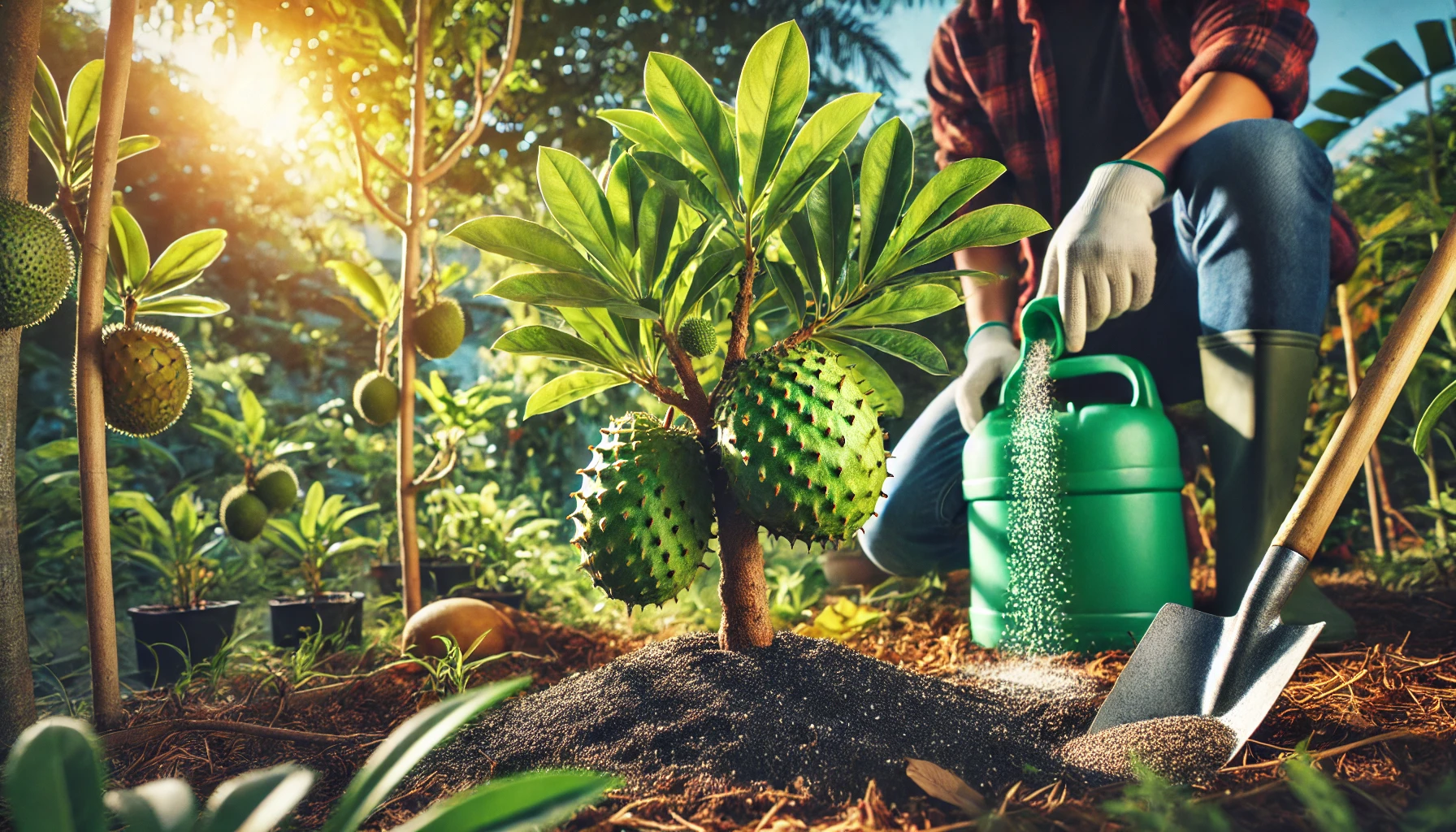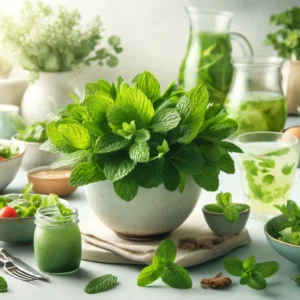Soursop, also known as Graviola, is a tropical fruit prized for its unique flavor and numerous health benefits. To cultivate a healthy and productive soursop plant, it is crucial to provide the right nutrients at each stage of growth. Organic fertilizers are an excellent choice, as they enhance soil health and provide essential nutrients without harmful chemicals. This article will guide you through fertilizing your soursop plant at each of its six growth stages: germination, seedling, vegetative growth, flowering, fruiting, and ripening.
Here’s the updated table with the “NPK Ratio” and “Nutrients” :
| Fertilizer | Nutrients | Benefits |
|---|---|---|
| Compost | NPK: 1-1-1, Balanced nutrients | Improves soil structure, increases microbial activity, enhances water retention |
| Manure | NPK: Varies (e.g., 0.5-0.2-0.4), Balanced nutrients | Adds organic matter, provides slow-release nutrients, improves soil aeration |
| Bone Meal | NPK: 4-12-0, High in phosphorus | Promotes root development, enhances flowering |
| Blood Meal | NPK: 12-0-0, High in nitrogen | Promotes lush growth, helps compost decomposition |
| Fish Emulsion | NPK: 5-2-2, Rich in micronutrients | Fast-acting, boosts plant growth |
| Seaweed Extract | NPK: 1-0-4, Trace minerals, growth hormones | Improves stress tolerance, enhances root development |
| Green Manure | NPK: Varies (e.g., 2-1-2), Nitrogen (legumes), organic matter | Adds organic matter, suppresses weeds, fixes nitrogen |
| Worm Castings | NPK: 1-0-0, Beneficial microbes | Enhances soil structure, provides slow-release nutrients |
| Alfalfa Meal | NPK: 3-1-2, Growth hormones | Promotes soil microbial activity, improves plant vigor |
| Cottonseed Meal | NPK: 6-2-1, Balanced nutrients | Acidifies soil, provides slow-release nutrients, improves soil texture |
| Bat Guano | NPK: 10-3-1, High in nitrogen | Promotes vigorous growth, rich in beneficial microbes |
| Feather Meal | NPK: 12-0-0, High in nitrogen | Slow-release fertilizer, promotes lush foliage |
| Neem Cake | NPK: 5-1-2, Balanced nutrients | Acts as a pesticide, enhances soil fertility, improves plant health |
| Kelp Meal | NPK: 1-0-2, Trace minerals | Promotes strong root development, enhances stress resistance |
| Coffee Grounds | NPK: 2-0.3-0.2, Nitrogen | Improves soil structure, attracts beneficial microorganisms |
| Molasses | NPK: 1-0-5, Energy source for microbes | Improves soil structure, enhances nutrient uptake |
| Rock Phosphate | NPK: 0-3-0, High in phosphorus | Promotes root growth, enhances flowering and fruiting |
| Wood Ash | NPK: 0-1-3, Potassium, calcium | Raises soil pH, provides potassium, contains trace elements |
| Epsom Salt | NPK: 0-0-0, Magnesium sulfate | Improves chlorophyll production, enhances nutrient uptake |
| Banana Peel Fertilizer | NPK: 0-3-42 (approximate), Potassium | Promotes strong root growth, enhances flowering and fruiting |
| Mustard Cake | NPK: 4-1-1, Balanced nutrients | Enhances soil fertility, promotes healthy plant growth |
| Eggshell Fertilizer | NPK: 1.2-0.4-0.1 (approximate), Calcium | Improves soil structure, reduces soil acidity, strengthens plant cell walls |
This table combines the NPK ratios with other nutrient information for a more streamlined presentation of each fertilizer’s key properties.
Here’s a table summarizing the stages of soursop plant growth, the duration of each stage, and the key signs:
| Growth Stage | Duration (Days) | Key Signs |
|---|---|---|
| Germination | 14-28 days | Seeds swell, sprout, and produce initial root (radicle) |
| Seedling | 30-60 days | Emergence of first true leaves, development of a small stem |
| Vegetative Growth | 60-120 days | Rapid leaf production, stem elongation, and root expansion |
| Flowering | 60-90 days | Formation of flower buds, blooming of flowers |
| Fruit Set and Development | 90-180 days | Flowers develop into small fruits, fruits begin to enlarge |
| Maturation and Harvest | 180-240 days | Fruits reach full size, develop characteristic color and aroma |
1. Germination Stage
Nutrients Needed: Phosphorus and Calcium.
- Phosphorus: When planting a soursop plant from seed, you can incorporate Rock Phosphate or Bone Meal fertilizer into the soil to provide essential phosphorus for root development. Use about 1 to 2 tablespoons of either Rock Phosphate or Bone Meal per planting hole. Mix the fertilizer thoroughly with the soil at the bottom of the hole before placing the seed. This ensures that the young soursop plant will have access to phosphorus as it establishes its root system. Phosphorus is crucial for early growth stages and overall plant health, promoting strong roots and vigorous growth. Water the newly planted seed thoroughly after planting to help settle the soil and activate the fertilizer.
- Calcium: When planting soursop seeds, use crushed eggshells or eggshell powder as a calcium-rich fertilizer. Aim for about one to two tablespoons per hole, ensuring they are well mixed into the soil. Supplement with compost or balanced fertilizer as the plant grows for best results. (To learn how to make Eggshell Powder, Click Here)
Benefits: The germination stage is the initial phase where the soursop seed begins to sprout. Phosphorus is essential during this stage as it promotes root development and energy transfer, which are vital for the seed to germinate effectively. Calcium helps in the formation of strong cell walls and roots, ensuring a robust start for the seedling.
Fertilization Tips: Use an organic starter mix rich in phosphorus, such as bone meal or rock phosphate. These can be mixed into the soil where the seeds are planted. Ensure the soil is well-drained and kept consistently moist to facilitate germination.
2. Seedling Stage
Nutrients Needed: Nitrogen, phosphorus, potassium
- Balanced Fertilizer: When planting the newly grown seedling on the ground we can use balanced fertilizer like (1-1-1 or 2-2-2) where main three nutrients (Nitrogen-Phosphorus-Potassium) are presents. That is why we can use compost or manure for soursop seedlings, mix 1 part compost with 3 parts soil for planting. Apply a thin layer (a couple of tablespoons) around each plant, avoiding direct contact with the stem. Water well after applying to help nutrients penetrate the soil. Adjust amounts as plants grow, ensuring not to over-fertilize. Regular monitoring of plant health will guide further applications.
Benefits: As the seedling emerges, it requires a balanced supply of nutrients to support its early growth. Nitrogen is critical for leaf and stem development, phosphorus continues to support root growth, and potassium enhances overall plant health and resistance to diseases.
Fertilization Tips: Apply a balanced organic fertilizer, such as compost or well-rotted manure. A mix of fish emulsion and seaweed extract can provide a good balance of N-P-K (Nitrogen-Phosphorus-Potassium). Apply the fertilizer every two weeks to maintain nutrient availability.
3. Vegetative Growth
Nutrients Needed: Nitrogen, magnesium, sulfur
- Nitrogen: During the vegetative growth stage of a soursop plant, you can use organic fertilizers like blood meal, bat guano, feather meal, or fish emulsion to promote healthy growth. Blood meal is high in nitrogen and can be applied at a rate of 1 tablespoon per plant scattered around the base and lightly worked into the soil every 4-6 weeks. Bat guano, rich in phosphorus and nitrogen, should be applied sparingly due to its potency; mix 1 tablespoon per gallon of water and apply as a soil drench once a month. Feather meal, a slow-release nitrogen source, can be used at a rate of 1-2 tablespoons per plant, mixed into the soil or applied as a top dressing every 6-8 weeks. Fish emulsion, a balanced fertilizer, can be diluted according to package instructions (usually 1-2 tablespoons per gallon of water) and applied as a foliar spray or soil drench every 2-4 weeks to provide essential nutrients. Always water plants thoroughly after applying fertilizers to prevent burn and ensure nutrients are absorbed effectively.
- Magnesium and Sulfur: To effectively use Epsom salt (magnesium sulfate) for your soursop plant during its vegetative growth stage, dissolve 1 tablespoon of Epsom salt in 1 gallon of water. Mix well until the Epsom salt crystals are completely dissolved. Use this solution to water your soursop plant once every two to four weeks, depending on its growth rate and soil condition. Make sure to apply the solution directly to the soil around the plant, avoiding foliage contact to prevent potential leaf burn. Magnesium from Epsom salt helps in chlorophyll production, which is crucial for photosynthesis and overall plant growth, especially during the vegetative stage. This application rate should provide adequate magnesium supplementation without risking over-fertilization.
Benefits: During the vegetative growth stage, the soursop plant focuses on developing its foliage and branches. Nitrogen remains crucial for the growth of leaves and stems. Magnesium is essential for chlorophyll production, which is necessary for photosynthesis, while sulfur aids in the formation of essential amino acids and enzymes.
Fertilization Tips: Continue with a nitrogen-rich organic fertilizer. Incorporate magnesium through the use of Epsom salts and sulfur through elemental sulfur or sulfate-based fertilizers. Apply these fertilizers monthly and ensure the soil remains well-drained but consistently moist.
4. Flowering Stage
Nutrients Needed: Phosphorus, potassium, boron
- Phosphorus: During the flowering stage of soursop plants, apply 1-2 tablespoons of rock phosphate or bone meal per plant. Sprinkle it around the base, gently work into the soil, and water well. Repeat every 4-6 weeks to support healthy growth and fruit development, adjusting amounts based on plant size and age to avoid over-fertilization.
- Potassium: During the flowering stage of your soursop plant, you can use wood ash by sprinkling about 1/4 to 1/2 cup evenly around the base of each plant, then gently work it into the top layer of soil. For banana peel fertilizer, chop up 1 or 2 peels per plant and bury them about 2 inches deep near the roots, repeating every 2 weeks. Alternatively, you can make liquid banana peel fertilizer by soaking chopped peels in water for a few days, then straining and diluting with water at a 1:3 ratio (1 part banana peel liquid to 3 parts water). Apply this diluted solution to the soil around each plant, avoiding direct contact with flowers. These organic fertilizers will provide nutrients to support healthy flowering and fruit development.
- Boron: Currently I cannot suggest any organic fertilizer that I can be sure boron in it. that is why buy a boron based fertilizer from store for providing your plant with the nutrients. Read the package for instructions.
Benefits: The flowering stage is critical for fruit production. Phosphorus is necessary for the formation of flowers and fruit set. Potassium enhances flower development and helps the plant withstand stress. Boron is essential for pollen tube growth, which is crucial for successful pollination.
Fertilization Tips: Switch to a fertilizer higher in phosphorus and potassium, such as bone meal and wood ash. Boron can be added through borax, but use it sparingly as excessive boron can be toxic. Apply these nutrients at the start of the flowering stage and repeat every few weeks.
5. Fruiting Stage
Nutrients Needed: Potassium, calcium, magnesium
- Potassium: For potassium use wood ash as fertilizer for a soursop plant in its fruiting stage, sprinkle a handful evenly around the base of the plant every 4-6 weeks, avoiding direct contact with the trunk. Or use banana peel fertilizer, chop up 1-2 peels per plant into small pieces, bury them in the soil near the roots, and repeat every 2-3 months. Alternatively, for liquid banana peel fertilizer, blend 1-2 peels with water, let it sit for a few days, then strain and dilute the liquid with water (1:3 ratio) before applying every 2 weeks as a soil drench, ensuring not to oversaturate. Adjust quantities based on plant response and size. ( To learn how to make Liquid Banana Peel Fertilizer, Click Here)
- Calcium: Use eggshell or eggshell powder on a soursop plant during its fruiting stage. Sprinkle this powder around the base of the plant, ensuring it covers the soil evenly. Use approximately a handful of crushed eggshells per plant. Eggshells provide calcium, which can help prevent blossom end rot and support fruit development. Repeat this application every 4-6 weeks throughout the fruiting season for best results. (To learn how to make Eggshell Powder, Click Here)
- Magnesium: During the fruiting stage of a soursop plant, you can use Epsom salt to promote healthy growth and fruit development. Dissolve 1 tablespoon of Epsom salt in 1 gallon of water and apply this solution to the base of the plant every 2-4 weeks. This provides magnesium, which aids in flower and fruit production. Avoid overuse as it may cause salt buildup in the soil.
Benefits: During the fruiting stage, the soursop plant diverts its energy to developing fruits. Potassium is vital for fruit size and quality, calcium strengthens cell walls and prevents blossom end rot, and magnesium continues to support photosynthesis and energy transfer.
Fertilization Tips: Use an organic potassium-rich fertilizer such as kelp meal or sulfate of potash. Calcium can be supplemented with lime or gypsum, and magnesium with Epsom salts. Apply these fertilizers at the onset of fruit development and continue monthly until the fruits reach full size.
6. Ripening Stage
Nutrients Needed: Potassium, trace elements
- Potassium: At ripening stage use wood ash, sprinkle about 1/4 to 1/2 cup around the base of the plant, avoiding direct contact with the stem. This provides potassium, which supports fruit development. Or use banana peel fertilizer, chop up 1 or 2 peels per plant and bury them near the roots or blend them into a liquid fertilizer by soaking in water for a few days, then dilute with water at a 1:3 ratio (one part liquid fertilizer to three parts water) before applying to the soil around the plant. This supplies nutrients like potassium, phosphorus, and calcium, aiding in fruit ripening and overall plant health. Apply these fertilizers every 4-6 weeks during the growing season for best results. ( To learn how to make Liquid Banana Peel Fertilizer, Click Here)
- Trace elements: To provide trace elements to a soursop plant during the ripening stage, you can use seaweed or kelp extract or fish emulsion. Dilute either seaweed or kelp extract to half strength according to the manufacturer’s instructions, and apply it to the soil around the plant every 2 weeks. For fish emulsion, mix 1 tablespoon with 1 gallon of water and use this solution to water the plant every 2 weeks. This will help ensure the plant gets essential trace elements during its ripening phase, supporting healthy fruit development.
Benefits: In the ripening stage, the fruits mature and develop their final flavor and nutritional content. Potassium remains essential for ensuring the fruits ripen evenly and develop a good taste. Trace elements like zinc, iron, and manganese support various biochemical processes within the fruit.
Fertilization Tips: Continue with a potassium-rich fertilizer, and add trace elements through a well-balanced organic mix or compost tea. Ensure the plant receives adequate water during this stage to prevent stress and support fruit development.
Conclusion
Fertilizing soursop plants with organic fertilizers throughout their growth stages ensures they receive the necessary nutrients for optimal health and productivity. By understanding the specific nutritional needs at each stage—germination, seedling, vegetative growth, flowering, fruiting, and ripening—you can provide targeted support that promotes vigorous growth, abundant flowering, and high-quality fruit production. Using organic fertilizers not only benefits your plants but also enhances soil health and sustainability, making it a win-win approach for both your garden and the environment.



